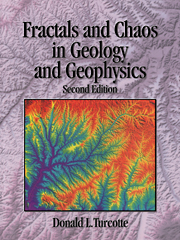Book contents
- Frontmatter
- Contents
- Preface
- Preface to the second edition
- 1 Scale invariance
- 2 Definition of a fractal set
- 3 Fragmentation
- 4 Seismicity and tectonics
- 5 Ore grade and tonnage
- 6 Fractal clustering
- 7 Self-affine fractals
- 8 Geomorphology
- 9 Dynamical systems
- 10 Logistic map
- 11 Slider-block models
- 12 Lorenz equations
- 13 Is mantle convection chaotic?
- 14 Rikitake dynamo
- 15 Renormalization group method
- 16 Self-organized criticality
- 17 Where do we stand?
- References
- Appendix A Glossary of terms
- Appendix B Units and symbols
- Answers to selected problems
- Index
13 - Is mantle convection chaotic?
Published online by Cambridge University Press: 05 June 2012
- Frontmatter
- Contents
- Preface
- Preface to the second edition
- 1 Scale invariance
- 2 Definition of a fractal set
- 3 Fragmentation
- 4 Seismicity and tectonics
- 5 Ore grade and tonnage
- 6 Fractal clustering
- 7 Self-affine fractals
- 8 Geomorphology
- 9 Dynamical systems
- 10 Logistic map
- 11 Slider-block models
- 12 Lorenz equations
- 13 Is mantle convection chaotic?
- 14 Rikitake dynamo
- 15 Renormalization group method
- 16 Self-organized criticality
- 17 Where do we stand?
- References
- Appendix A Glossary of terms
- Appendix B Units and symbols
- Answers to selected problems
- Index
Summary
The Lorenz equations are a low-order expansion of the full equations applicable to thermal convection in a fluid layer heated from below. For the range of parameters in which chaotic behavior is obtained, the low-order expansion is not valid; higher-order terms should be retained. Nevertheless, the chaotic behavior of the low-order analog is taken as a strong indication that the full equations will also yield chaotic solutions. Numerical solutions of the full equations are strongly time dependent for high Rayleigh number flows; these solutions appear to be turbulent or chaotic.
It is generally accepted that thermal convection is the primary means of heat transport in the earth's mantle. Heat is produced in the mantle due to the decay of the radioactive isotopes of uranium, thorium, and potassium. Heat is also lost due to the cooling of the earth. The surface plates of plate tectonics are the thermal boundary layers of mantle convection cells. The plates are created by ascending mantle flows at ocean ridges. The plates become gravitationally unstable and founder into the mantle at ocean trenches (subduction zones). Intraplate hot spots such as Hawaii are attributed to mantle plumes that ascend from the hot unstable thermal boundary layer at the base of the convection mantle.
An important question with regard to the earth is whether mantle convection is chaotic. The earth's solid mantle behaves as a fluid on geological time scales because of thermally activated creep.
- Type
- Chapter
- Information
- Fractals and Chaos in Geology and Geophysics , pp. 269 - 278Publisher: Cambridge University PressPrint publication year: 1997



